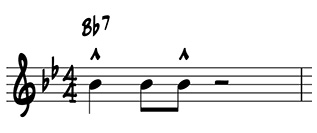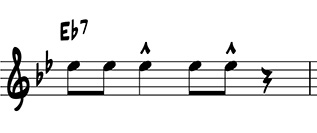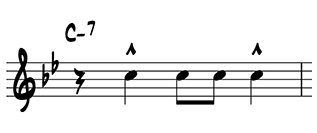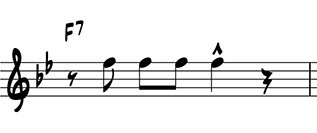Index - Introduction - Lessons
Definition of a riff: a short musical idea.
Throughout the history of jazz, much of the music has been based on the creation and development of musical riffs. Riffs can be part of a planned musical composition, or they can be the basis of improvisation. In the early days of jazz, and especially during the swing era, riffs were a very important part of the music.
Creating and playing riffs is also a great way to learn how to improvise. This first exercise focuses on rhythm and the creation of simple ideas based on the root of each chord in the B flat blues.
Part 1: Compose
Compose four unique one-measure riffs, based on one pitch -- the root of the individual chords of the B flat blues we are using. (For free blank staff paper, visit www.Music-Paper.com)
Note that all of the pitches that are mentioned are in concert key. If you play an instrument that is not in concert key, like saxophone, clarinet, or trumpet, transpose the pitches to your appropriate key.
Part 1.1: Compose a one-measure riff on the pitch B flat. Here is an example of a basic jazz riff:

Part 1.2: Compose a one-measure riff on the pitch E flat. For example:

Part 1.3: Compose a one-measure riff on the pitch C. For example:

Part 1.4: Compose a one-measure riff on the pitch F. For example:

Suggestions: Keep your riffs simple and memorable. Ideas that are complex or complicated are not necessarily good ideas (that will be a recurring theme throughout this method).
Part 2: Memorize
Memorize the riffs that you have composed and play each one along with the matching recording of the sustained chords of the B flat blues. Repeat each riff many times until you can play them all effortlessly. Listen closely to yourself and listen to the recording. Focus on rhythm and make sure to swing.
Part 3: Improvise
Improvise one measure riffs on the root of each of the sustained chords, just as you did in the composition exercise. Play along with the recordings for each sustained chord. Remember to find what sounds good to you! Since you are only playing one pitch, focus on the rhythm. Swing hard and listen to yourself and the rhythm section.
Suggested exercises for solo practice:
Trade “fours” with yourself. “Trading fours” means that you play for four measures and then someone else plays for four measures. This process often repeats many times. If you are practicing by yourself, improvise a one-measure riff and then repeat that riff three more times, creating a four-measure phrase. After that, improvise a new one-measure riff and repeat it three more times, creating another four-measure phrase. Continue this pattern and trade fours with yourself. Here is an example of how your improvisation might sound:

You can also trade twos or ones with yourself. Another very effective practice technique involves using silence between your fours. In other words, play your one-measure riff four times, and then play nothing for four measures. Using silence in this way helps us to listen better and understand the importance of silence and space in music.
Suggested exercises for group practice:
Trade fours, twos, and ones with the other musicians.
A good listening exercise: have a musician play a one-measure riff and have the rest of the musicians play that same exact riff in an echo.
Lesson 2 teaches the form of the blues.

If you like this site, please share it with others!


Like Kyle Coughlin Music on Facebook
Follow Kyle Coughlin Music on Twitter